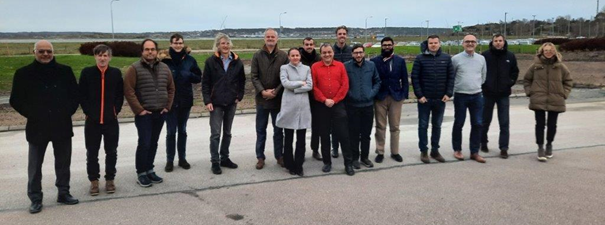The GO-VIKING consortium gathered for a hybrid meeting at Vattenfall’s Ringhals Nuclear Power Plant for its highly anticipated Third Progress Meeting, held on November 22nd and 23rd, 2023. This hybrid event provided a platform to showcase the substantial advancements made over the past six months and outline the challenges ahead for the GO-VIKING project.
DAY 1: KNOWLEDGE EXCHANGE AND INNOVATIONS

The meeting commenced with a warm welcome and an overview of the day’s agenda, setting the stage for insightful discussions. To kick things off, attendees gained a comprehensive understanding of the Ringhals NPP, thanks to an engaging presentation by M. Adsten from Vattenfall. Following this introduction, the GO-VIKING Project Office, represented by M. Gross and G. Niedermeyer from LGI and GRS, delivered a detailed report on the project’s recent progress, spotlighting pivotal achievements that continue to shape the project’s trajectory.
The meeting then transitioned into the project’s technical activities, yielding valuable insights. D. Vivaldi from IRSN led a session exploring the latest trends and developments, with a primary focus on flow-induced vibrations (FIV) in nuclear power plants and the associated methodologies. H. Hadžić from Framatome provided updates on research concerning fuel assembly-related FIV, while K. Zwijsen of NRG illuminated advancements in understanding and managing FIV in steam generators. Partners from EDF delved into the intricate realm of multiphase flows, shedding light on experiments designed to deepen our knowledge. A. Papukchiev from GRS explored the synergy of fast-running methods, uncertainty quantification, and best practice guidelines, making FIV analyses computationally efficient and clarifying key sources of uncertainties.
These discussions highlighted significant progress in the GO-VIKING project’s experiments, modelling capabilities and the related numerical work. For instance, in the Cantilever Rod modeling work at NRG, initial tests revealed minor amplitude prediction discrepancies, while closely matching experimental frequencies, showcasing promising results. In GRS’ AMOVI modeling with ANSYS CFX, lift force exhibited a slight overestimation, yet drag force results aligned well with expectations. The two-phase Cantilever rod experiments are already running, while the purchase of the main components for the GOKSTAD facility has already begun. These achievements underscore the project’s commitment to advancing knowledge in flow-induced vibrations and enhancing nuclear power plant safety.
DAY 2: REVIEW, EDUCATION AND COMMUNICATION

The second day commenced with a session, attended by the project management board members, where they assessed the project’s progress and determined the next steps to further advance our understanding of FIV and power plant safety. The morning concluded with a final series of presentations, featuring GO-VIKING’s education, training, and dissemination activities, led by P. Planquart from VKI. The main focus of the discussions was set on the yearly lecture on FIV, and the final dates for the educational material delivery.
Following an early lunch, in-person participants of the progress meeting had the unique opportunity to visit and to put hands on the Ringhals Nuclear Power Plant simulator.
ADVANCING NUCLEAR SAFETY: THE GO-VIKING GOAL
The GO-VIKING project aims to deliver a safer and more sustainable future for nuclear power generation. By focusing on the challenges of Flow-Induced Vibrations (FIV), the project is paving the way for improved nuclear plant operation and safety, contributing to a more reliable low-carbon energy source for our future.
Stay up to date with our latest insights and progress by following us on LinkedIn and Twitter. Don’t forget to subscribe to our newsletter to get all the project’s developments and discoveries in your inbox.


